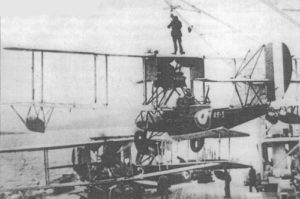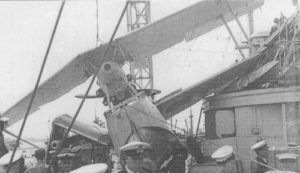- Author
- Vickridge, G.L.W., Lieutenant, RANR
- Subjects
- Ship design and development, Naval technology
- Tags
-
- RAN Ships
- 816 Squadron, HMAS Albatross, HMAS Hobart I, HMAS Melbourne II, 851 Squadron
- Publication
- September 2000 edition of the Naval Historical Review (all rights reserved)

Two very different types of aircraft are being hoisted in the two photographs in this article. The open cockpit Seagull III, A9-3 is seen being hoisted inboard to HMAS Albatross. While the pilot (RAAF) or observer (RAN) is standing on the upper wing, the air gunner (RAN) is seen manning the .303 Lewis gun amidships. The aircraft were hoisted out by one of the three electric cranes and, weather permitting, took off from and landed on the water, from where they were hoisted inboard when the wings were capable of being folded manually. The skeg, in place of a rear wheel, and the rudder for steering whilst waterborne can clearly be seen. Powered by a single Napier Lion V engine of 450hp, the cruising speed of the Seagull III was a sedate 85 knots; it took 11 minutes to climb to 5,000 feet.
Six Vickers Supermarine Seagull III amphibians were ordered in 1925 to replace the ageing Fairey HID seaplanes which were used in the aerial survey and fleet co-operation roles. The order (which was subsequently increased to nine by the purchase of three former RN Fleet Air Arm aircraft) coincided with the decision to build a seaplane carrier for the RAN. The aircraft, of wood frame construction, were flown by No. 101 Fleet Co-operation Flight, an RAAF unit which was under the operational control of the Navy. The last example was disposed of in 1936.

HMAS Albatross was commissioned at Sydney on 23 January 1929 and on 25 February embarked six Seagull aircraft with 46 pilots and airmen. The ship’s company numbered 450. Although the 4,800 ton (full load 6,000 tons) ship had a capacity for six aircraft, it usually only carried six throughout its relatively brief RAN career. HMAS Albatross was well armed with four 4.7 inch AA guns, two 2-pdr pour-pours, four 3-pdrs and several smaller guns. In March 1933, as a result of the economic depression, HMAS Albatross was paid off into reserve. Although recommended, a launching catapult was not fitted to the ship until 1936. It recommissioned on 19 April 1938 and sailed from Sydney on 11 July for transfer to the Royal Navy in part payment for the cruiser Hobart.

On the outbreak of World War II, HMS Albatross was used as an aircraft repair vessel in home waters but in the following year, was stationed in Sierra Leone, for trade protection and as a mobile base and workshop. Converted to a fleet repair ship in 1942, it served as such at the Normandy landings. Albatross was paid off in 1945 after surviving striking a mine and being bombed on several occasions. Three years later, the ship was bought and converted to a passenger transport under the name, Hellenic Price. Later chartered by the International Refugee Organisation, the former seaplane carrier arrived at Sydney with 1,000 displaced persons and migrants on 5 December 1949. In 1953 the British Government chartered the ship to transport troops to Kenya but after grounding in Mombasa and repairs in Colombo, the time had come where the former RAN seaplane carrier was no longer economically viable. Sold to Hong Kong buyers, Albatross was scrapped in 1954.




